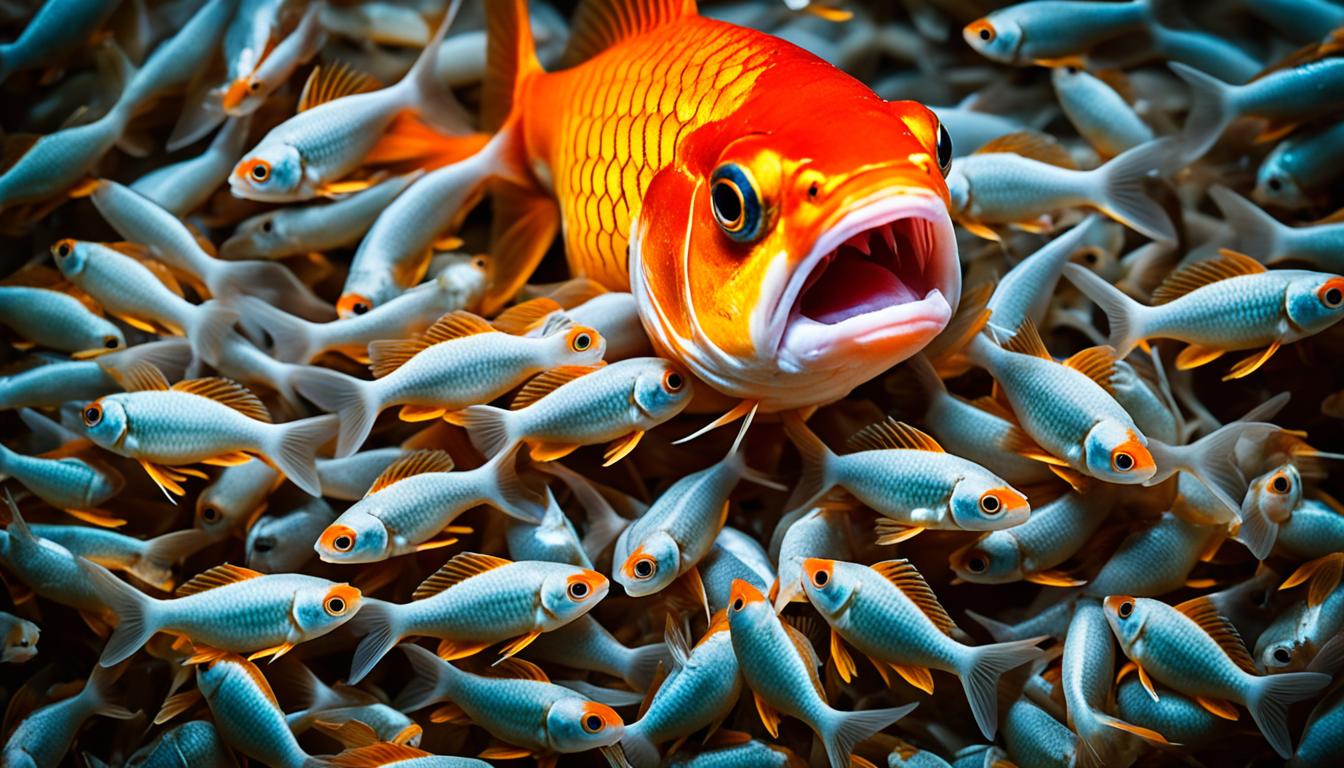Last Updated on 2 weeks by admin
Goldfish are beloved pets known for their vibrant colors and lively personalities. As responsible goldfish owners, it’s essential to provide them with a nutritious and balanced diet. One question that often arises is, can goldfish eat bloodworms? In this article, we will explore the safety of feeding goldfish bloodworms and share some important diet tips to keep your finned friends happy and healthy.
Key Takeaways:
- Goldfish can eat bloodworms as part of a balanced diet, but moderation is key.
- Bloodworms are a rich source of protein and can provide a nutritious snack for goldfish.
- Handle live bloodworms with care to prevent them from biting your goldfish.
- Choose reputable sources for bloodworms to ensure their safety and quality.
- Offer a diverse diet to meet all of your goldfish’s nutritional needs.
What Are Bloodworms?
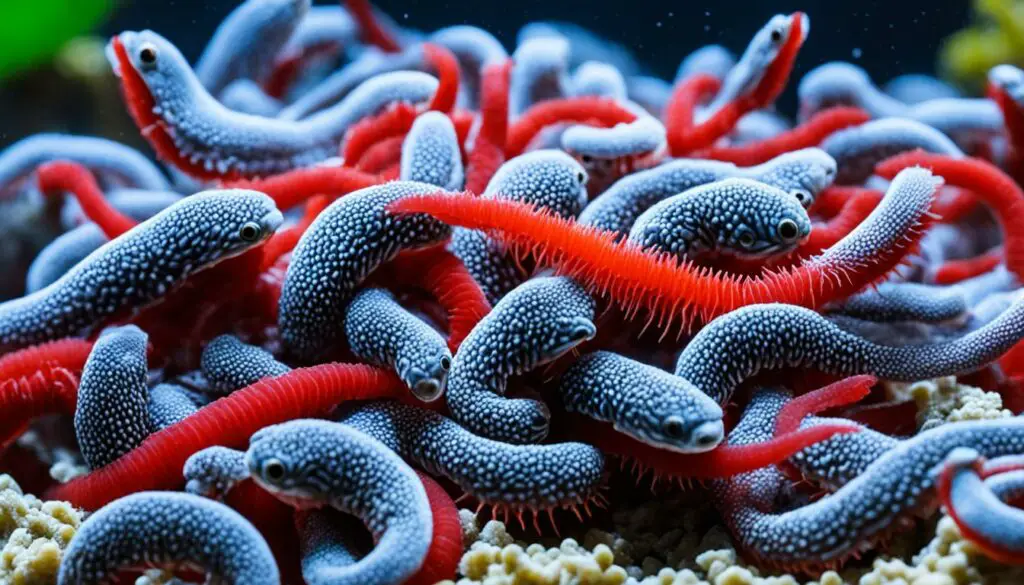
Bloodworms are the larvae of a midge fly and are categorized as polychaetes. These small creatures inhabit the bottom of marine lakes, where they feed on decaying organic waste and detritus. They are known for their deep red color, which is a result of their unique diet and habitat. Originally used as bait for marine fish, bloodworms quickly gained popularity among aquarium hobbyists as a nutritious and appetizing snack for their pet fish.
Bloodworms come in three forms for feeding to aquarium fish: live, frozen, and freeze-dried. Each form has its own benefits and requires specific preparation methods before being fed to goldfish and other aquarium fish species.
As a staple of aquarium fish diets, bloodworms offer a natural and protein-rich food source that can enhance the nutritional value of the overall diet. Their vibrant red color and wriggling movement entice fish, stimulating their predatory instincts and providing a much-needed mental and physical exercise.
Goldfish Dietary and Protein Requirements

Goldfish require a balanced and varied diet to remain healthy. As omnivorous fish, they need a combination of plant-based nutrients and animal-sourced proteins to thrive. Protein is particularly crucial for their growth and development.
A staple diet for goldfish typically consists of commercially produced goldfish flakes or pellets. These specially formulated foods provide essential nutrients and are designed to meet the dietary requirements of goldfish.
In addition to the staple diet, it is beneficial to supplement their meals with fresh vegetables, such as blanched zucchini, cucumber, lettuce, and skinned peas. These vegetables provide additional vitamins and minerals that promote overall health.
“A varied diet is important to avoid common digestive disorders and promote buoyancy in goldfish.”
One often overlooked aspect of a goldfish’s diet is the inclusion of algae. Algae can be beneficial as it contains essential nutrients and serves as a natural source of plant-based protein. It can be offered in the form of algae wafers or simply by allowing algae to grow naturally in the tank.
Key Components of a Goldfish’s Diet
| Food Type | Description |
|---|---|
| Commercially Produced Goldfish Flakes | High-quality flakes or pellets specifically formulated for goldfish, providing essential vitamins, minerals, and a balanced combination of proteins and carbohydrates. |
| Fresh Vegetables | Incorporate blanched zucchini, cucumber, lettuce, skinned peas, and other greens into the goldfish’s diet to provide additional vitamins and fiber. |
| Algae | Offer algae wafers or encourage the growth of natural algae in the tank as a source of plant-based protein and essential nutrients. |
While protein is important for goldfish, it is crucial to note that a balanced diet encompasses a variety of nutrients. Therefore, supplementing their meals with bloodworms occasionally can be beneficial. Bloodworms are a meat-based protein source that can provide essential amino acids and contribute to a diversified diet.
“A balanced and varied diet ensures that goldfish receive all the essential nutrients they need to thrive.”
By carefully considering their dietary requirements and providing a combination of commercially produced goldfish flakes, fresh veggies, and even algae, goldfish owners can help ensure their pets remain healthy and vibrant.
Can Live Bloodworms Infect or Harm Goldfish?
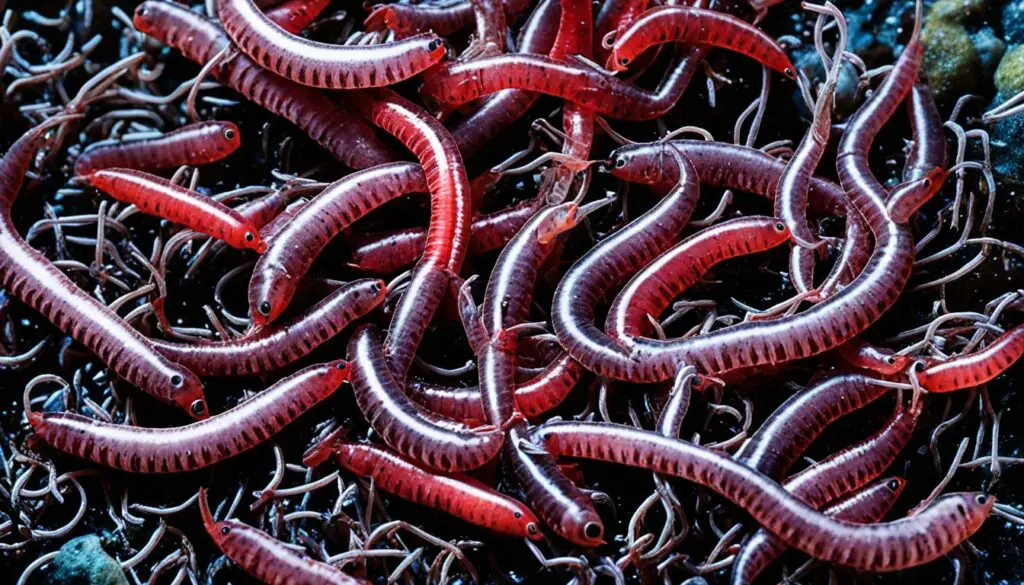
Live bloodworms are generally safe to feed to goldfish, as long as they come from a reputable source. However, it’s important to take precautions and handle them properly to ensure the well-being of your goldfish.
When it comes to live bloodworms, one concern is the potential for diseases or parasites. To avoid introducing harmful pathogens into your fish tank, it’s crucial never to collect bloodworms or any other live food from the natural environment. Instead, opt for bloodworms from a reliable and reputable source.
Live bloodworms have four fangs that they can use to bite and latch onto their prey. While this might be a natural behavior for bloodworms, it can cause harm to your goldfish. To prevent them from biting your goldfish, it’s advisable to wear rubber gloves when handling live bloodworms.
When planning to feed live bloodworms to your goldfish, consider the following guidelines:
- Choose bloodworms from a reliable and reputable source.
- Handle live bloodworms with rubber gloves to avoid getting bitten.
- Feed them in moderation to prevent overfeeding and maintain a balanced diet.
- Monitor your goldfish for any signs of distress or illness after feeding them live bloodworms.
The Importance of a Reputable Source
Sourcing bloodworms from a reputable supplier is crucial to ensure their safety and quality. Reputable sources typically maintain strict hygiene standards and take measures to prevent the presence of diseases or parasites in their bloodworms.
By choosing bloodworms from a reputable source, you can have peace of mind knowing that you are providing your goldfish with a safe and healthy food option.
How to Feed Frozen Bloodworms to Goldfish
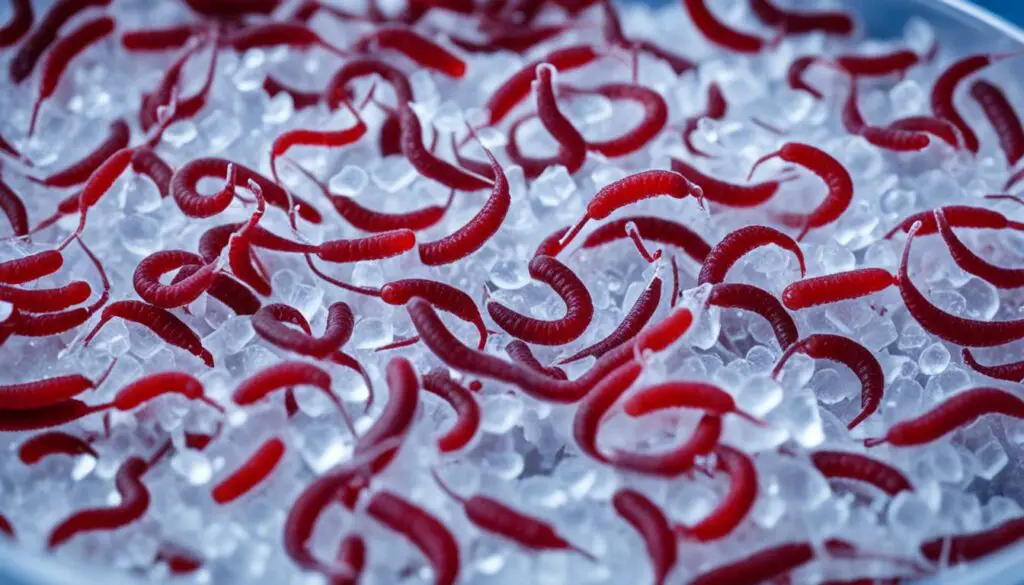
Frozen bloodworms are a convenient option for feeding your goldfish. They provide a nutritious and protein-rich snack for your fish. Here’s a step-by-step guide on how to feed frozen bloodworms to your goldfish:
- Start by purchasing frozen bloodworms from a reputable fish store. Make sure they are specifically designed for feeding to goldfish.
- Most frozen bloodworms come in the form of cubes. Take a cube out of the pack and chip off a section that you want to feed to your goldfish.
- Place the section of the cube on a plate or in a small container with some aquarium water.
- Allow the bloodworms to thaw completely. This usually takes around 5-10 minutes.
- Once the bloodworms are thawed, you can add them to the fish tank.
The portion size of frozen bloodworms will depend on the size of your goldfish. It’s important not to overfeed them. As a general guideline, feeding them half a cube per goldfish is recommended. Monitor your goldfish’s behavior and adjust the portion size accordingly.
Feeding frozen bloodworms to your goldfish can be an enjoyable and nutritious treat. Just remember to follow the feeding instructions and not to overfeed your fish with this tasty snack.
| Advantages of Feeding Frozen Bloodworms | Disadvantages of Feeding Frozen Bloodworms |
|---|---|
| – Convenient option – Nutritious and protein-rich – Can be easily portioned – Stimulates natural instincts |
– Requires thawing – May be more expensive than other options – Can get messy if not handled properly |
Featured Quote:
“Feeding frozen bloodworms to your goldfish can provide them with a nutritious and protein-rich snack, while stimulating their natural instincts.” – Goldfish Enthusiast
How to Feed Freeze-Dried Bloodworms to Goldfish
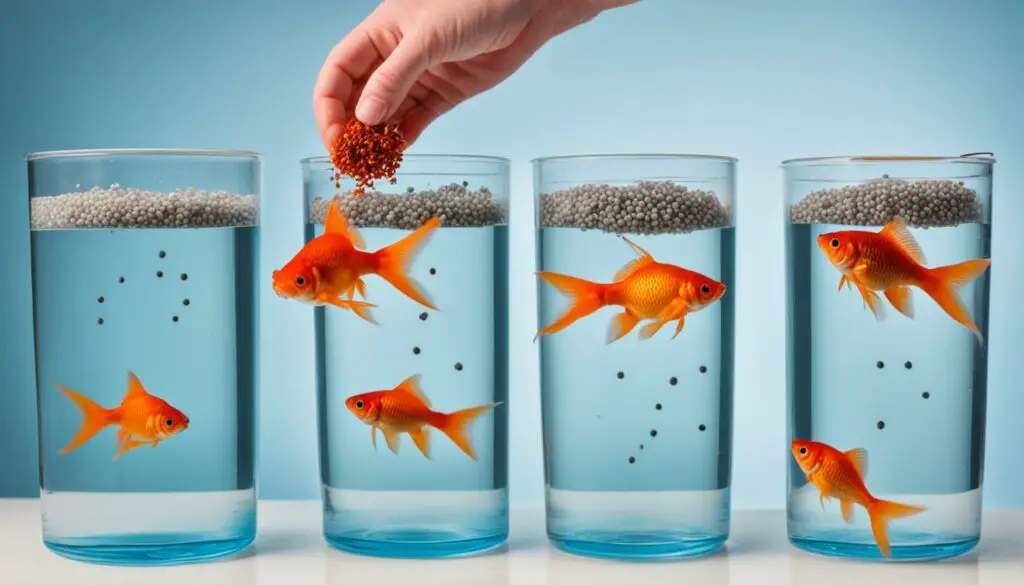
Freeze-dried bloodworms are another option for feeding goldfish. These convenient treats offer a long shelf life and can be easily stored. However, before offering them to your fish, it’s important to rehydrate the bloodworms to ensure they are easier for your goldfish to consume.
To rehydrate freeze-dried bloodworms, follow these simple steps:
- Take a small amount of aquarium water and place it in a container.
- Add the freeze-dried bloodworms to the container.
- Allow the bloodworms to soak for approximately 10 minutes.
- The bloodworms will absorb the water and become soft and moist.
Once the freeze-dried bloodworms are rehydrated, use a few worms at a time and offer them to your goldfish by dropping them into the tank.
Feeding instructions:
- Start by offering a small portion of freeze-dried bloodworms to your goldfish.
- Observe your goldfish’s response and adjust the portion size accordingly.
- Feed freeze-dried bloodworms as a treat or supplement to their regular diet.
- Remember to provide a well-rounded diet that includes other nutritious foods.
Here’s an image showing the rehydration process of freeze-dried bloodworms:
By rehydrating freeze-dried bloodworms, you can ensure that your goldfish can enjoy these tasty treats without any difficulty. Remember to offer them in moderation and always provide a balanced and varied diet to meet your goldfish’s nutritional needs.
How Many Bloodworms Can You Feed Your Goldfish?
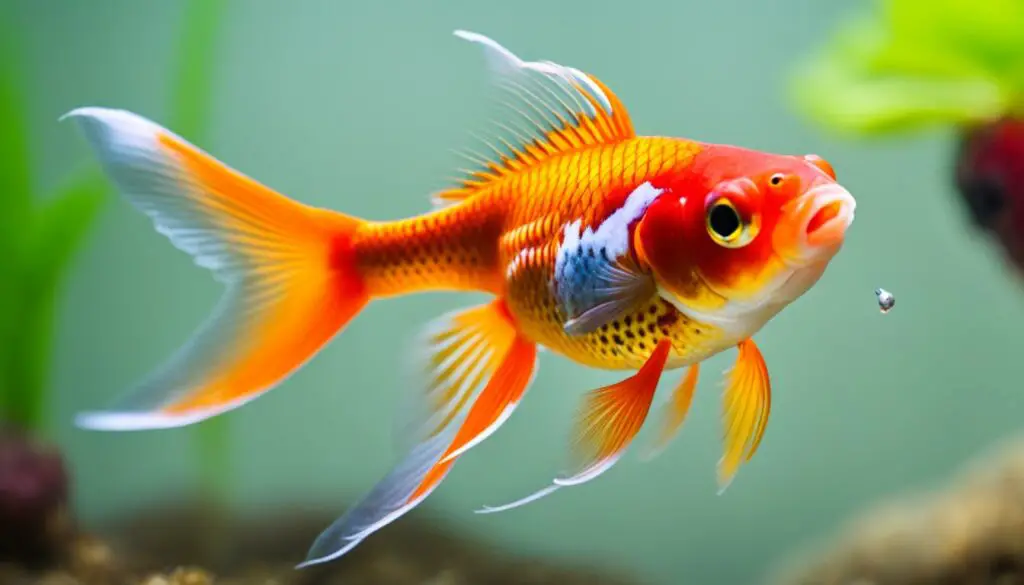
Feeding your goldfish the right amount of bloodworms is crucial to ensure their health and well-being. The number of bloodworms you can feed to your goldfish depends on factors such as their size and age. By following appropriate feeding guidelines, you can prevent nutritional imbalances and digestive issues. Here’s a general dosage recommendation:
- Juvenile Goldfish: For young goldfish, it is recommended to feed them a maximum of 10 bloodworms per week. This portion size provides them with an adequate amount of protein while still maintaining a balanced diet.
- Adult Goldfish: Adult goldfish can consume up to 4 bloodworms per week. Alternatively, feeding them one bloodworm as part of their daily diet is also acceptable. Remember to consider their overall diet and ensure they receive other nutritious foods.
It’s essential not to overfeed your goldfish with bloodworms, as excessive consumption can lead to nutritional deficiencies and digestive problems. A varied diet that includes other suitable food options is crucial to meet their dietary requirements.
By adhering to these feeding guidelines, you can ensure that your goldfish enjoy the benefits of bloodworms while maintaining optimal health and nutrition.
“Feeding your goldfish the right amount of bloodworms is crucial to ensure their health and well-being.”
Benefits of Bloodworms for Goldfish
Feeding bloodworms to goldfish offers a multitude of benefits. These nutritious larvae serve as an excellent protein source, fostering the growth and development of your goldfish. But the advantages do not stop there.
- Exercise and Mental Stimulation: When goldfish are presented with bloodworms, their natural predatory instincts are triggered. Chasing and consuming the wriggling bloodworms not only provides exercise but also mental stimulation, keeping your goldfish active and engaged.
- Spawning Behavior: Bloodworms can also stimulate spawning behavior in goldfish. The presence of these live or freeze-dried delicacies can encourage goldfish to exhibit their natural reproductive instincts, fostering a healthy breeding environment.
- Digestive Health: Incorporating bloodworms into your goldfish’s diet can contribute to their overall digestive health. The high protein content aids in maintaining proper digestive function and preventing digestive issues.
While bloodworms offer numerous benefits, it’s important to remember that they should be part of a varied and balanced diet to fulfill all of your goldfish’s nutritional needs. Additionally, always feed bloodworms in moderation to avoid overfeeding and to maintain a healthy diet for your goldfish.
So, by including bloodworms in your goldfish’s menu, you not only provide them with a protein-rich snack, but also engage their natural instincts, promote spawning behavior, and support their digestive health.
The table below summarizes the benefits of bloodworms for goldfish:
| Benefits of Bloodworms for Goldfish |
|---|
| Rich source of protein |
| Stimulates exercise and mental stimulation |
| Encourages spawning behavior |
| Promotes digestive health |
Risks of Bloodworms for Goldfish
While bloodworms have their benefits, it’s important to be aware of the potential risks associated with feeding them to goldfish. Understanding these risks can help you make informed choices and maintain the health and well-being of your goldfish.
Nutritional Deficiencies
One of the main risks of feeding too many bloodworms to goldfish is the potential for nutritional deficiencies. While bloodworms are a rich source of protein, they lack a variety of other essential nutrients, vitamins, and minerals that goldfish require for optimal health. Goldfish need a balanced diet that consists of both plant-based nutrients and animal-sourced proteins.
| Nutrients | Benefits | Sources |
|---|---|---|
| Protein | Essential for growth and development | Bloodworms, commercially produced goldfish flakes or pellets |
| Vitamins | Support various bodily functions | Fresh vegetables, algae |
| Minerals | Aid in bone development and overall health | Commercially produced goldfish flakes or pellets, fresh vegetables |
Excessive Fat and Constipation
Another risk of feeding an excessive amount of bloodworms is the high fat content. While goldfish do require some fat in their diet, overfeeding them with fatty foods like bloodworms can lead to constipation and other digestive issues. It’s essential to provide a balanced diet that includes a variety of food sources to prevent these complications.
Parasites
Bloodworms can also carry parasites if they are sourced from unsafe or wild-caught specimens. These parasites can potentially infect and harm your goldfish. To minimize this risk, it’s crucial to source bloodworms from reputable suppliers who follow proper hygiene and safety protocols.
By being aware of these risks and taking necessary precautions, you can continue to incorporate bloodworms into your goldfish’s diet while ensuring their overall health and well-being.
Sourcing Bloodworms for Goldfish
When it comes to sourcing bloodworms for your goldfish, you have three main options: live bloodworm culture, frozen bloodworms, and freeze-dried bloodworms.
Live bloodworm culture is the most nutritious choice for your goldfish, as it provides them with fresh and live food. However, it requires setting up a live culture, which involves some equipment and maintenance. If you have the time and resources, cultivating your own live bloodworms can be a rewarding experience that ensures a high-quality food source for your goldfish.
Frozen bloodworms are a convenient alternative that is readily available in most fish shops. These bloodworms are flash-frozen to preserve their nutritional value and can be stored in the freezer for long-term use. When feeding your goldfish frozen bloodworms, be sure to thaw them properly before offering them as a treat.
Another option is freeze-dried bloodworms. These bloodworms have the advantage of a longer shelf life, making them a convenient choice. However, they may have less nutritional value compared to their fresh or frozen counterparts.
When sourcing bloodworms for your goldfish, it’s important to choose a reliable supplier to ensure their safety and quality. Look for reputable brands or sellers who prioritize the well-being of the fish they provide food for. By selecting trustworthy sources, you can be confident in the quality of the bloodworms you offer to your goldfish.
Conclusion
In conclusion, goldfish can safely consume bloodworms as part of their regular diet. Feeding bloodworms to goldfish in moderation can provide them with an additional protein source and stimulate their natural instincts. However, it is crucial to remember that bloodworms should be incorporated into a varied and balanced diet, following specific feeding guidelines for goldfish.
When feeding bloodworms to goldfish, it is important to source them from reputable suppliers to minimize the risks associated with parasites and other contaminants. Live bloodworms, frozen bloodworms, and freeze-dried bloodworms are the most common types available. Live bloodworms are highly nutritious but require setting up a live culture. Frozen bloodworms offer convenience and can be stored long-term, while freeze-dried bloodworms have a longer shelf life but may have reduced nutritional value.
By following the recommended feeding guidelines and sourcing bloodworms from reliable suppliers, you can safely incorporate bloodworms into your goldfish’s diet. This ensures your goldfish receives the benefits of bloodworms, such as additional protein, stimulation of natural instincts, and potential digestive health improvement, while minimizing the risks associated with nutritional imbalances and parasites.
FAQ
Can goldfish eat bloodworms?
Yes, goldfish can eat bloodworms as part of their regular diet.
What are bloodworms?
Bloodworms are the larvae of a species of midge fly that are deep red in color and are commonly used as a bait for marine fish.
What are the dietary requirements for goldfish?
Goldfish require a balanced and varied diet that includes plant-based nutrients as well as animal-sourced proteins to remain healthy.
Can live bloodworms harm goldfish?
Live bloodworms are generally safe to feed goldfish if sourced from a reputable supplier. It’s important to handle them with care to avoid getting bitten.
How do you feed frozen bloodworms to goldfish?
To feed frozen bloodworms to goldfish, thaw a section of the cube in aquarium water and add it to the tank for the goldfish to nibble on.
How do you feed freeze-dried bloodworms to goldfish?
Soak freeze-dried bloodworms in aquarium water for about 10 minutes to rehydrate them before offering them to your goldfish in small portions.
How many bloodworms can you feed your goldfish?
The number of bloodworms to feed your goldfish depends on their size and age. As a general guideline, juveniles can have a maximum of 10 bloodworms per week, while adults can have up to 4 bloodworms per week.
What are the benefits of bloodworms for goldfish?
Bloodworms provide goldfish with a rich source of protein, stimulate their natural instincts, and promote their digestive health.
What are the risks of bloodworms for goldfish?
Feeding too many bloodworms can lead to nutritional deficiencies and constipation. Bloodworms can also carry parasites if not sourced from a reputable supplier.
How do you source bloodworms for goldfish?
Bloodworms can be sourced from live bloodworm cultures, frozen bloodworms available in fish shops, or freeze-dried bloodworms stored in airtight containers.
Can goldfish eat bloodworms as their main diet?
No, bloodworms should be fed in moderation as part of a varied and balanced diet to fulfill all of the goldfish’s nutritional needs.
Source Links
- https://www.hepper.com/can-goldfish-eat-bloodworms/
- https://smartaquariumguide.com/goldfish-eat-bloodworms/
- https://www.aquariadise.com/can-goldfish-eat-bloodworms/

